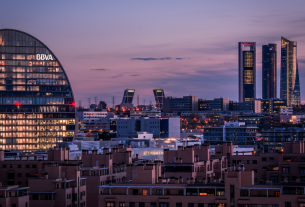|
Getting your Trinity Audio player ready...
|
We already know that the climate crisis is making heatwaves longer, more frequent and more intense. We all experienced that first hand last summer. In fact the summer temperature in Europe in 2022 was the highest on record.
Less well known is the impact of this heat on our health. In the most extreme cases, heat can be fatal: in summer 2022, Spain recorded over 4,600 deaths attributable to temperatures exceeding 40°C. And we know that the situation will likely get worse in the future before it gets better, with 90,000 Europeans at risk of dying from heat every year in the next decades if we don’t do more to cut greenhouse gas emissions globally.
The problem is most urgent in cities, as buildings and roads absorb and retain heat, and there’s often reduced vegetation and fewer bodies of water. This means that urban areas tend to be significantly warmer compared to neighbouring rural areas – a phenomenon called “urban heat island”. With around 75% of Europeans living in cities, the potential health threat is huge.
We need to act now both to prepare better for heatwaves and protect ourselves from their severe consequences. Here are a few examples of how the EU is helping Europeans to do just that.
Embracing nature as an ally

LIFE LUNGS – Planting trees to cool down Lisbon, Portugal
© LIFE LUNGS
One way of addressing climbing temperatures in built up areas is to make use of nature’s own resources, or what the experts call “nature-based solutions”. According to a study published earlier this year by renowned scientific journal The Lancet, increasing tree coverage to 30% in cities could prevent almost 40% of deaths related to urban heat islands. The EU is on board; in addition to the 3 Billion Trees Pledge launched last year to increase the tree coverage across Europe by 2030, the EU is also funding smaller local projects making use of the natural cooling effect provided by vegetation to protect European city dwellers from extreme temperatures.
As part of the LIFE LUNGS project, some 240,000 plants will be planted around Lisbon in Portugal in 2024 to strengthen the city’s resilience to rising temperatures. Similarly, the LIFE Green Heart project will significantly increase the green surface area in Toulouse, France, reducing the temperature in the city by around 3°C during heatwaves.
The LIFE@Urban Roofs project in Rotterdam, Netherlands, is planting green roofs across the city. This is expected to add an extra 20,000 square metres to the city’s green infrastructure by 2024. Meanwhile in Poland, the LIFE Archiclima project is helping to adapt big buildings (such as shopping centres and airports) to extreme heat. With the airport of Katowice serving as a pilot, the concept will be replicated in 32 other locations across the EU, by greening the roofs, walls, and outdoor spaces of these large structures. As a result, average temperatures in their surroundings are expected to drop by some 2°C during heatwaves.
Technology to the rescue

LIFE TreeCheck – Tackling extreme heat in central Europe with a smartphone
© Veronika Kovářová, Czech Environmental Partnership Foundation / LIFE TreeCheck (2022)
But nature is not our only ally here. The LIFE PACT project – launched in Leuven, Belgium, and to be replicated in other parts of Europe – is developing a digital tool that will enable people to register trees they plant and other natural solutions they apply in their gardens. They will be able to compare the progress of their “green projects” with that of others through an online platform, allowing the city to keep track of green spaces, particularly on private property, which are often a blind spot in adaptation strategies.
As part of the LIFE TreeCheck project, active in Czechia, Slovakia, Hungary and Poland, two separate IT tools for climate adaptation have been developed. The “Tree Check App” for smartphones allows people to identify tree varieties and rewards them with digital prizes if they take actions such as tree watering. Meanwhile the “Tree Check Pro” app enables urban planners to forecast the benefits of tree planting in the city over time and adapt their plans to cool local temperatures as much as possible.
Similarly, two IT systems for climate adaptation are being created as part of the LIFECOOLCITY project. The “EUROPE system” will assess green infrastructure in 10,000 cities across the EU, while the “CITY system” will be running in Wrocław, Poland, to identify where in the city natural solutions are needed most – such as the planting of new vegetation – to protect people from heatwaves.
Last but not least, thanks to an urban heat forecasting system, the LIFE ASTI project is helping European citizens adapt to the effects of increasing temperatures. Running in three Mediterranean cities – Rome (Italy), Thessaloniki (Greece) and Heraklion (Greece) – the project involves installing weather monitoring stations and setting up a warning system to inform citizens, via a mobile app, when the temperatures might be dangerous for their health.
What else is the EU doing?
With these kinds of projects, the EU is supporting work on the ground in Member States – exactly where climate adaptation should be put into action.
But these local actions are just elements of a broader European policy to make our society more resilient to the effects of the climate crisis, and health is becoming a key aspect of it. Climate adaptation is at the heart of the European Climate Law (article 5), and as part of the EU Adaptation Strategy, the European Climate and Health Observatory was launched in 2021.
The Observatory sets out to better understand, anticipate and minimise the health threats caused by climate change, so far focusing on heat and climate-sensitive infectious diseases. It allows decision makers to monitor, anticipate and reduce climate-related health risks and helps them shape national health policies and systems accordingly.
The EU’s wide-reaching Mission Adaptation to Climate Change supports over 300 EU regions, cities and local authorities in their efforts to build resilience against the impacts of climate change – including health aspects.
With these EU-wide policies and initiatives, and with the EU funding for adaptation projects focusing on human health, we’re off to a good start. Now it’s up to European countries, regions, cities and communities, as well as to all Europeans, to follow suit with national and municipal adaptation strategies, local actions, and changes in lifestyle.
Climate change is already here and even if we reduce our greenhouse gas emissions as planned to reach climate neutrality in Europe by 2050, some consequences are unavoidable and will stay with us for decades. It is up to us to adapt to protect what’s most precious to us: our health and our lives.

